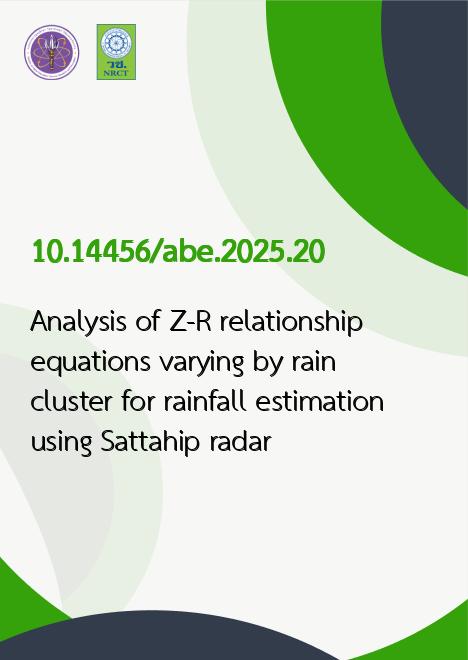
|
Analysis of Z-R relationship equations varying by rain cluster for rainfall estimation using Sattahip radar |
|---|---|
| รหัสดีโอไอ | |
| Creator | Ratchawatch Hanchoowong |
| Title | Analysis of Z-R relationship equations varying by rain cluster for rainfall estimation using Sattahip radar |
| Contributor | Siwa Kaewplang |
| Publisher | Faculty of Engineering, Khon Kaen University |
| Publication Year | 2568 |
| Journal Title | Agricultural and Biological Engineering |
| Journal Vol. | 2 |
| Journal No. | 4 |
| Page no. | 145-151 |
| Keyword | Weather radar, Radar reflectivity, Raindrops, Sattahip radar |
| URL Website | https://ph04.tci-thaijo.org/index.php/abe |
| Website title | ThaiJo |
| ISSN | 3056-932X (Online) |
| Abstract | Weather radar measures the reflectivity of radar waves when they interact with raindrops. This radar reflectivity varies according to the size and distribution pattern of the raindrops. When using radar reflectivity data to estimate rainfall, this data is converted to rainfall intensity (R, (mm/h)) using the Z-R relationship equation (Z=aRb). This study collected data from 510 rainfall events between February 2, 2018, and August 31, 2020, comprising hourly rainfall from 110 automatic rain gauges and radar reflectivity within a 240 km radius of the Sattahip radar. The data was analyzed to determine the most appropriate rainfall estimation using various Z-R relationship equations: Z-R relationships that vary according to rain clusters based on radar reflectivity, Z-R relationships that vary according to rain clusters based on rainfall intensity measured by automatic rain gauges, climatological Z-R equation, Z=300R1.4, and Z=200R1.6. Each of these rainfall estimations was then compared to the rainfall intensity from automatic rain gauges to find the statistical values of RMSE (Root Mean Squared Error), MSE (Mean Squared Error), and MAE (Mean Absolute Error). The results indicated that the rainfall estimation method using Z-R relationships that vary according to rain clusters based on rainfall intensity provided the most accurate rainfall estimation for the Sattahip radar. This was determined by examining the statistical values of RMSE, MSE, and MAE, which were closest to zero for both calibration and verification rainfall events, when compared to rainfall estimation methods using Z-R relationships that vary according to rain clusters based on radar reflectivity, climatological Z-R equation, Z=300R1.4, and Z=200R1.6 respectively. |